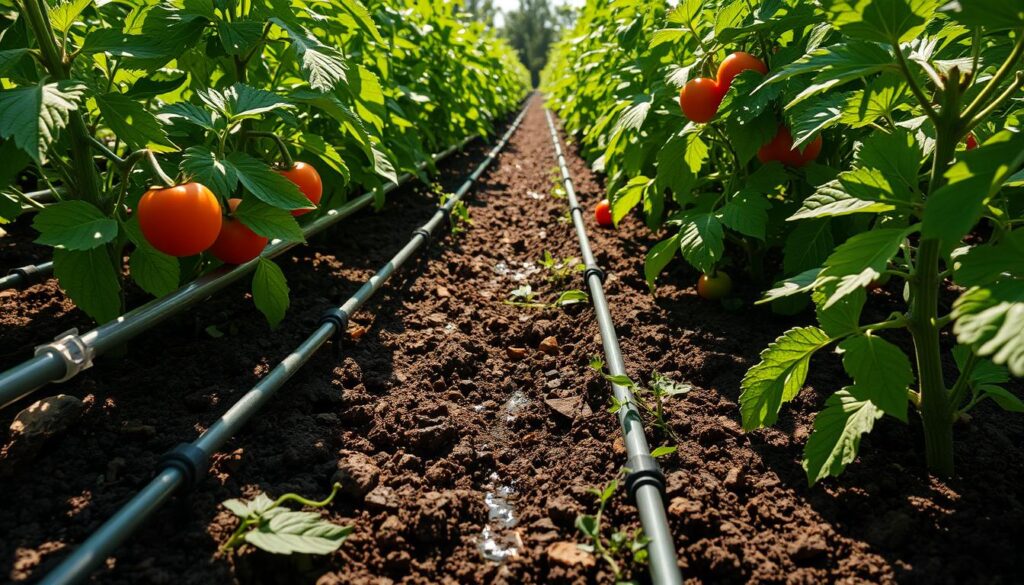In this article, I’ll share practical strategies and techniques to help you create a thriving vegetable garden. This garden will require minimal effort and maintenance. Whether you’re a busy professional, a novice gardener, or simply looking to save time, you’ll discover how to grow abundant, healthy produce with a low-maintenance approach.
By embracing sustainable and time-saving gardening methods, you can enjoy the benefits of fresh, homegrown vegetables. You won’t have to deal with the hassle of constant upkeep.
Key Takeaways
- Discover how to create a vegetable garden that requires minimal effort and maintenance
- Learn practical strategies for planning, preparing, and maintaining a low-maintenance garden
- Explore time-saving techniques and efficient watering strategies to optimize your garden’s productivity
- Understand effective weed control and organic pest management methods to keep your garden thriving
- Maximize your garden’s space and yield through vertical gardening and companion planting
Planning Your Low-Maintenance Garden
Starting a vegetable garden doesn’t have to be hard. By planning well and choosing easy vegetables, you can have a great harvest with little work. Let’s look at the important steps for a beginner-friendly garden.
Choosing the Right Location
Finding the best spot for your garden is key. Think about sunlight, soil, and how easy it is to get to. Look for a place that gets at least 6 hours of sunlight a day. Also, check if the soil drains well and has the nutrients your plants need.
Selecting Easy-to-Grow Vegetables
Some vegetables are easier to grow than others. Tomatoes, bell peppers, zucchini, cucumbers, and leafy greens like lettuce and kale are great choices. These plants are tough and don’t need much care. They make your garden easy to manage.
With the right garden plan and easy vegetables, you’re ready for a great gardening experience. Next, we’ll talk about preparing the soil for your garden.
“The glory of gardening: hands in the dirt, head in the sun, heart with nature. To nurture a garden is to feed not just the body, but the soul.” – Alfred Austin
Preparing the Soil for Minimal Effort
Healthy, nutrient-rich soil is key for a thriving, low-maintenance vegetable garden. Adding organic matter to your soil is essential. It improves the soil’s structure and fertility, giving your plants the nutrients they need to grow well with little care.
Compost is a great way to enrich your soil. It’s a nutrient-dense, organic material that makes soil better at holding water. As it breaks down, it slowly releases nutrients that plants can absorb. Adding a lot of compost to your garden beds before planting is a simple, green way to prepare the soil.
You can also use other organic amendments to make your soil more fertile. Aged manure, peat moss, and even shredded leaves or grass clippings can all help. These materials feed your plants and support the growth of beneficial microorganisms in the soil. This creates a healthy, easy-to-care-for ecosystem.
| Organic Amendment | Benefits |
|---|---|
| Compost | Improves soil texture and water retention, releases essential nutrients over time. |
| Aged Manure | Adds nitrogen, phosphorus, and other key nutrients to the soil. |
| Peat Moss | Increases water-holding capacity and improves drainage in heavy soils. |
| Shredded Leaves/Grass Clippings | Provides organic matter and gradually releases nutrients as it decomposes. |
By using these sustainable soil preparation practices, you can create a nutrient-rich base for your garden. With a little effort, you’ll enjoy a bountiful harvest.

“Healthy soil is the foundation of a successful, low-maintenance garden. By focusing on sustainable soil preparation, you can set your plants up for long-term success with minimal ongoing effort.”
How to Create a Low-Maintenance Vegetable Garden
Creating a thriving, low-maintenance vegetable garden is possible with the right techniques. Using raised beds, no-till gardening, and square foot gardening can greatly reduce the time and effort needed. This way, you can enjoy a bountiful harvest with less work.
Implementing Time-Saving Techniques
Raised beds are great for gardeners who value their time. They make it easy to reach your plants without bending or kneeling. This makes weeding and harvesting more comfortable. Plus, raised beds help with drainage and soil quality, making your plants healthier and needing less care.
No-till gardening is another way to save time in your garden. It avoids tilling the soil, which helps keep the soil’s structure and nutrient cycles better. This means you’ll need to water and weed less often, giving you more time for other garden activities.
Square foot gardening is a smart way to use your space and save time. It divides your garden bed into 1-foot squares, making it easy to plan and manage your plants. This method also makes watering, weeding, and harvesting more efficient, making your garden efficient and low-maintenance.
“Embrace the power of raised beds, no-till gardening, and square foot gardening to create a vegetable garden that works for you, not the other way around.”
Efficient Watering Strategies
To keep your vegetable garden healthy, you need a smart watering plan. Using efficient methods saves water, cuts down on work, and makes sure your plants get enough water. This helps them grow well.
Drip Irrigation Systems
Drip irrigation is a top choice for easy watering. It sends water straight to your plants’ roots. This cuts down on water loss and makes sure your plants get the right amount of moisture.
It’s not only time-saving but also helps save water. This makes it perfect for gardens that use less water.
Mulching to Retain Moisture
Adding organic mulch around your plants is also smart. Mulch stops water from evaporating too fast. It keeps the soil moist longer.
This simple trick means you don’t have to water as often. It makes gardening easier and less stressful.
Using drip irrigation and mulching together makes a great garden. It saves water, keeps the soil moist, and lets your plants grow with little help. These smart watering tips are key to a successful, water-saving garden.

“Efficient watering is the key to a thriving, low-maintenance vegetable garden. Embrace these strategies, and watch your garden flourish with minimal effort.”
Weed Control Made Easy
Keeping your vegetable garden weed-free can seem hard. But, with smart strategies, you can fight weeds easily. One top way is to use mulching. A thick layer of organic material on the soil blocks weeds and keeps moisture in for your plants.
Cover crops are another smart trick. Plants like clover or rye grass grow between your veggies. They beat out weeds and make the soil better. Just turn them into the soil when you’re ready to plant, and they’ll feed your crops.
For easy weeding, try raised beds and paths. This design limits where weeds can grow. It lets you focus on the best parts of your garden. With these sustainable weed management tips, you can have a weed-free garden with little work.
| Weed Prevention Technique | Benefits |
|---|---|
| Mulching | Smothers weed growth, retains moisture |
| Cover Crops | Outcompetes weeds, improves soil fertility |
| Raised Beds and Permanent Paths | Reduces weed-prone areas, focuses maintenance |
“By embracing sustainable weed management strategies, you can enjoy a thriving, weed-free vegetable garden with minimal time and effort.”
Pest Management Without Hassle
Keeping your vegetable garden healthy doesn’t have to be a fight. Organic pest control and welcoming beneficial insects can make your garden balanced and low-impact. This way, you can keep pests away with little effort.
Organic Pest Control Methods
Using natural insect repellents is a smart move. Essential oils from plants like peppermint, lemongrass, and citronella keep pests away without harming your veggies. You can make your own spray to use on your plants.
Attracting good bugs is also key. Ladybugs, lacewings, and praying mantises eat pests like aphids and caterpillars. Planting flowers and herbs for nectar and pollen helps these beneficial insects stay in your garden.
| Organic Pest Control Methods | Benefits |
|---|---|
| Natural Insect Repellents | Deter a wide range of garden pests without harming vegetables |
| Attracting Beneficial Insects | Encourage natural predators to control common garden pests |
By using these organic methods, your garden can thrive without harsh chemicals. It’s all about creating a balanced system that works with nature.
Maximizing Space with Vertical Gardening
When space is tight, vertical gardening can be a big help. Using trellises, cages, and other vertical setups lets you grow more small-space vegetables. This method saves space and makes your garden look better.
Vertical gardening boosts high-yield gardening in small areas. By training plants like tomatoes and cucumbers to climb, you can grow more in the same space. This way, you save space and keep plants healthy by improving air flow.
“Vertical gardening allows me to grow a diverse array of vegetables in my small backyard. It’s a game-changer for maximizing my space-saving techniques and getting the most out of my compact vegetable production.”
Another plus of vertical gardening is how easy it is to care for. Plants off the ground mean less weeding and fewer diseases. Plus, they get more sun, which helps them grow better.
To start vertical gardening, pick sturdy trellises or cages. You can also use old ladders or fencing. Choose what fits your space and the needs of your small-space vegetables. With some creativity, you can turn your garden into a productive high-yield gardening spot.
Embracing Companion Planting
Placing certain plants strategically can greatly benefit your low-maintenance garden. Companion planting helps create a thriving ecosystem. It deters pests, improves soil, and reduces the need for constant care.
Beneficial Plant Combinations
Pairing plants that complement each other is key in companion planting. For instance, marigolds near tomatoes can ward off nematodes. Basil repels insects from peppers. Carrots and radishes together confuse carrot flies, lowering infestation risk.
Some plant combinations also boost nutrient-sharing and soil health. Legumes like beans or peas fix nitrogen, helping nearby plants. A diverse garden with these “polyculture” plantings is low-maintenance and self-sustaining.



Leave a Reply